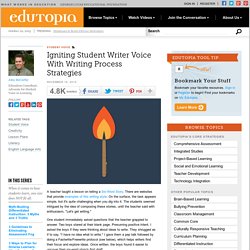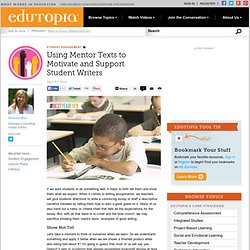

Creating a Writers' Workshop in a Secondary Classroom. In the middle of the school year, I always regret my choice of becoming an AP and Honors English teacher.

Not because I hate to teach, but because I'm always swimming in essays that I have to grade. In order to accommodate the load, I adapted the elementary way of thinking and formed a writers' workshop for my own classroom. Once they participate in the workshop, students are able to learn how to revise their own essays. Because of this, the time it takes for me to grade essays is literally cut in half. Suggestions for Implementing a Writers' Workshop in Your Classroom 1. When I conduct writers' workshops in my own classroom, I adapt the station rotation model of blended learning. 2. Every time I conduct a writers' workshop, I survey the students and ask them what skills they would like to practice. Examples of Stations 1. 2.
For those who use Google documents in their schools, Kaizena is an excellent resource. 4 Steps to Better Writers. Clarity.

It is what we long for when we travel through a student's essay. Yet our struggling writers make us wander through a cluttered maze of thoughts, leading to dead ends. We want an awareness of purpose. We want ideas to progress in logical order. We want sentences to be fluid and confident, not stuffed with words desperate to impress. A few years ago I had a Steve Jobs infatuation. Only when you consider where we were can you appreciate this accomplishment. It got me thinking about a theory of four. I came up with POET, a simple and effective pre-writing strategy for your students. P = Purpose Every strong essay had an unwavering commitment to the purpose. O = Organization The best essays have a system of organization. E = Evidence Weak essays make claims -- and that's it. T = Thesis (with insight) Repeating the prompt is the refuge of students that lack either originality or confidence.
Sure, there are things that this outline leaves out. Find 25 anchor charts for teaching writing in your classroom writers workshops. Anchor charts are a great way to make thinking visible as you record strategies, processes, cues, guidelines and other content during the learning process.

Here are 25 of our favorite charts for teaching your students all about writing. The Why Behind Writers Workshops Source: The First Grade Parade First and second graders will draw inspiration from this fun-filled anchor chart about why we write. Make this chart applicable to older students by expanding on each aspect with a specific audience or goal. "To share experiences" can become "to share experiences with friends, in a postcard or with readers in a memoir. " Setting Goals Source: second-grade writing-goals chart sets goals around important writing skills for younger students: punctuation, and vocabulary. Source: Juice Boxes and CrayolasIt's the icing on the cake! Looking for more? Igniting Student Writer Voice With Writing Process Strategies. A teacher taught a lesson on telling a Six-Word Story.

There are websites that provide examples of this writing style. On the surface, the task appears simple, but it's quite challenging when you dig into it. The students seemed intrigued by the idea of composing these stories, until the teacher said with enthusiasm, "Let's get writing. " One student immediately asked questions that the teacher grappled to answer. Two boys stared at their blank page. Learning how to write can be further challenging when a student lacks confidence in his or her skills as a writer. Pre-Writing Many aspiring writers struggle with developing and refining their ideas. Fastwrite/Freewrite This two-part protocol helps writers break through barriers and write. LA Youth » Archives. Write Source - Student Models.
Using Mentor Texts to Motivate and Support Student Writers. If we want students to do something well, it helps to both tell them and show them what we expect.

When it comes to writing assignments, we teachers will give students directions to write a convincing essay or draft a descriptive narrative followed by telling them how to earn a good grade on it. Many of us also hand out a rubric or criteria chart that tells all the expectations for the essay. But, with all that there is to cover and the time crunch, we may sacrifice showing them mentor texts, examples of good writing.
Show Not Tell Let's take a moment to think of ourselves when we learn: Do we understand something and apply it better when we are shown a finished product while also being told about it? So if we want students to write a convincing persuasive essay that includes evidence, let's show them examples. Now, I know what some of you are thinking: when I show them a student model it often gets copied or parroted back! So how do we keep students from mimicking or from freezing up? The Teacher Triathlete: Reflections on the Past Year of Writing Workshop.